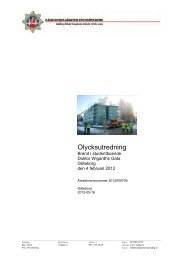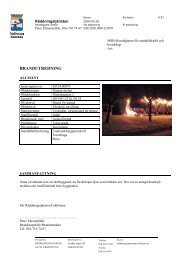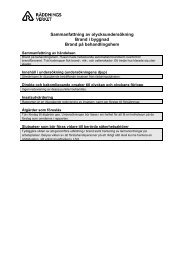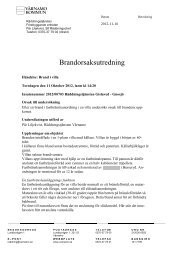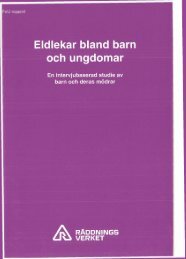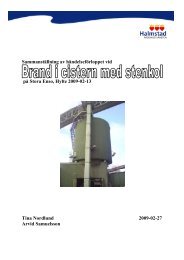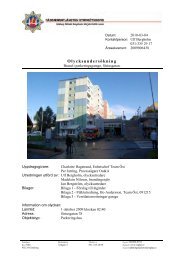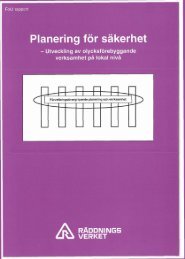Sverige
Sverige
Sverige
You also want an ePaper? Increase the reach of your titles
YUMPU automatically turns print PDFs into web optimized ePapers that Google loves.
kris och lärdom 11<br />
ter professionals report dramatically increased contact<br />
traffic as soon as the disaster is evident.<br />
Earlier research shows that when the significance<br />
of communication in crisis contexts increases, the information<br />
function is upgraded. This has meant that<br />
the head of communications has been placed in the<br />
command group – and sometimes even assigned a<br />
leading role in the response. This has also been observed<br />
in the actual events in this study. In some municipalities,<br />
however, the communicator has been assigned<br />
a less prominent role with production tasks only; in<br />
which case, communication responsibilities have been<br />
assigned to an administrative manager. We can also<br />
imagine that a staff-assigned communicator will have<br />
problems maintaining contact with the rest of the information<br />
function, and some of the interviewees emphasise<br />
that this should actually be accounted for in<br />
the disaster response organization.<br />
Concerning the organization of the information<br />
and communication unit, the lessons learned by several<br />
municipalities is that this work should be localized<br />
and take place in a facility that is directly connected<br />
to the command/staff function. This leads to more rational<br />
and coherent communications. A practical and<br />
concrete illustration would be to mount a large notice<br />
board that both staff and communicators can see and<br />
use for making notes of incoming, handled and outgoing<br />
facts and details.<br />
One frequent division between the information and<br />
command/staff functions is specifically that the latter,<br />
and more precisely the staff commander (head of rescue<br />
operations, for example) is responsible for media<br />
contact, while the former handles relations with local<br />
residents and other external groups, and internal information.<br />
The staff commander handles media contacts<br />
because the media to a major extent want direct<br />
information from decision-makers.<br />
Besides media contacts, the communication response<br />
in the first instance takes the form of web information<br />
both internally and externally, via websites and<br />
the intranet. A special information service is usually<br />
set up or expanded if this service already exists as a<br />
normal function – contact with the general public requires<br />
high telephone and switchboard capacity and<br />
a strong information service in terms of scope and<br />
competence. Traditional printed material such as flyers<br />
and posters are also used to reach all residents in<br />
certain situations. Information meetings and home<br />
visits are organized in some types of disasters, when<br />
the infrastructure has been damaged for example and<br />
power and telecom networks break down. During the<br />
January storm of 2005, traditional methods such as<br />
communication meetings and door-to-door distribution<br />
of messages were used because modern electronic<br />
media did not function.<br />
The reliance on web information should be discussed.<br />
Information in this form has the advantage of being<br />
accessible from both home and at work – for the<br />
people who can access and use this technology. Website<br />
information also has the advantage being up to<br />
date. Compared with many other channels, people in<br />
other parts of the country (and all around the world),<br />
such as relatives who want information can access<br />
websites. The disadvantage is that some parts of the<br />
population do not have internet access, particularly<br />
older people. The internet is also vulnerable to the power<br />
outages caused by storms and snow storms. As<br />
are mobile phone services if network operators lose<br />
their electricity supply.<br />
In situations where the population needs fasts information,<br />
radio broadcasts (via VMA or traffic reports)<br />
can be used. VMA (Important Message to the<br />
Public) has been used in a number of the studied cases,<br />
including gas accidents, and is considered limited to<br />
urgent warnings and brief instructions that require<br />
immediate attention. Information via the radio’s traffic<br />
information service functioned badly, according to<br />
several of the January storm’s disaster professionals,





